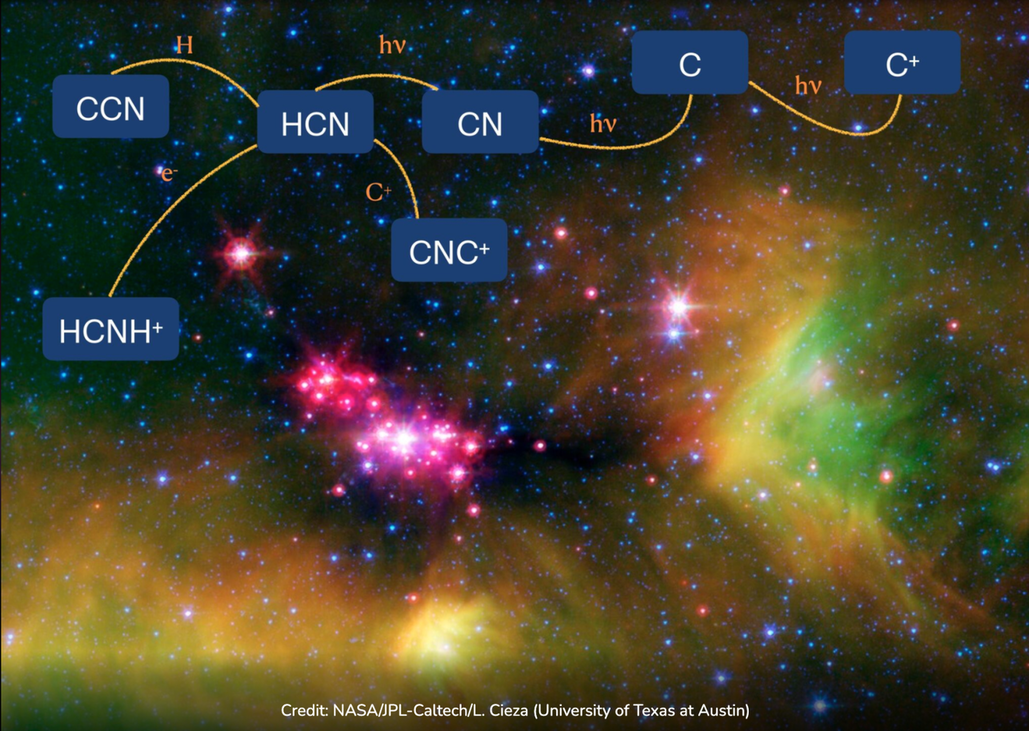Astronomy Object of the Month: 2022, February
< previous Archive next >
Serpens: the star-forming region and UV riddle
How does ultraviolet radiation influence the process of forming new stars and the entire
planetary systems? The topic remained largely unexplored until astronomers from UMK and UJ
have decided to take a closer look. The results they have achieved can provide more details
concerning our origins in space.

Illustration: Infant stars are glowing
gloriously in this infrared image of the Serpens star-forming region, captured by NASA's
Spitzer Space Telescope. Credit: NASA/JPL-Caltech/L. Cieza (University of Texas at Austin).
Protostars are young, still forming stars. In the future, they will produce energy from the nuclear fusion. Dr Agata Karska from the Institute of Astronomy at the Faculty of Physics, Astronomy and Informatics, NCU, and mgr Agnieszka Mirocha from OAUJ, together with collaborators, are concerned with the UV radiation observed in the vicinity of protostars and its meaning for the formation of new objects as well as planetary systems surrounding them. How do low-mass objects such as our Sun form? Thanks to this field of research we can also gain new information concerning distant past of our planet Earth.
Young stars can be found in clouds composed of dust and gas, impermeable to visible light, which makes observations of such objects quite problematic. Observations at longer electromagnetic waves, particularly in the far infrared, are necessary because this is where the dust brightness peaks, and also in the sub-millimeter range with key molecular transitions useful for the measurements of the temperature and density of a gas surrounding a protostar. While visible and ultraviolet light are completely absorbed by dust grains, due to observations of rotational lines of molecules in the sub-millimeter range we are able to determine the temperature and density of the gas as well as the amount of different molecules surrounding a protostar. With such knowledge, one can draw conclusions concerning physical and chemical processes leading to the formation of stars and planets.
By analyzing the presence of water molecules around protostars it was earlier possible to confirm the occurrence of UV radiation in low-mass star-forming regions. However, the observations were carried out with the use of the Herschel space telescope and could not be continued since its mission was accomplished in 2014. Thus, the researches had a different idea: they proposed to use the HCN and CN molecules, which can be also observed directly from the Earth's surface. Recent studies based on observations of these molecules with the use of the IRAM telescope located in Spain can be found in the new article published in a prestigious "Astronomy & Astrophysics" journal. Its first author is Agnieszka Mirocha, astronomer from the Jagiellonian University in Cracow.
The idea was based on taking a closer look at the presence of two molecules, namely, HCN and CN, in a molecular cloud in the star-forming Serpens region, named Serpens Main. They were considered as the indicators of where and how intensely UV radiation occurs. There are various molecules presenting different properties in a gas found in the cloud surrounding the protostar. Their abundance in such gas results from the efficiency of chemical reactions leading to their production and destruction, which depend on physical conditions as well as additional processes such as illumination with UV radiation.
Until recently, astronomers were not certain whether protostars are the source of UV radiation. At present, we know that even though they do not emit it themselves, the matter falling from a disk onto a star not only changes the structure of a shock wave leading to increased compression of a gas but also creates a very hot, illuminated region. When a dust-gas cloud surrounding a protostar falls in, we deal with accretion which is the agglomeration of matter on a star. Frequently, the so-called accretion shock is observed and temperature significantly rises in the place where the matter has fallen. Due to rotation and accretion processes, in the presence of magnetic field, a certain portion of matter is cast out to space again, in the form of molecular outflows. The outflow of matter and its interaction with the dusty and gaseous envelope creates shock waves, in which a sharp rise in temperature and density occurs. Then, UV photons can be produced.
According to the team, these molecular outflows are the source of the UV radiation observed in a star-forming cloud in the Serpent constellation. The study shows that HCN and CN molecules are good indicators of UV radiation, and in the studied star-forming region the dominant reaction that destroys HCN molecules is their reaction with UV photons. Simultaneously, CN molecules are more resistant to photodissociation. This means that the same photon that destroys HCN usually does not destroy CN – in the case of the latter molecule, even more energetic UV radiation is needed.
Original publication: Agnieszka Mirocha, Agata Karska, Marcin Gronowski, Lars E. Kristensen, Łukasz Tychoniec, Daniel Harsono, Miguel Figueira, Marcin Gładkowski, Michał Żółtowski, „Signatures of UV radiation in low-mass protostars I. Origin of HCN and CN emission in the Serpens Main region”, A&A 656, A146 (2021).
The research is part of research conducted at the Department of Stellar and Extragalactic Astronomy of the Jagiellonian University’s Astronomical Observatory (OAUJ). The research was funded by the National Science Centre (grant NCN 2016/21/D/ST9/01098) and by the Foundation for Polish Science (grant First TEAM No. POIR.04.04.00-00-5D21/18-00).
|
Agnieszka Mirocha Astronomical Observatory Jagiellonian University A.Mirocha [at] oa.uj.edu.pl |


